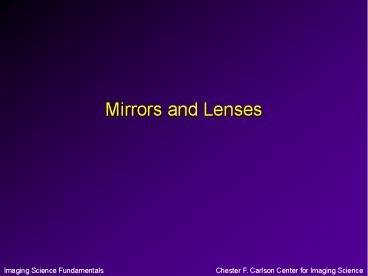Mirrors and Lenses - PowerPoint PPT Presentation
1 / 20
Title:
Mirrors and Lenses
Description:
Mirrors and Lenses ... – PowerPoint PPT presentation
Number of Views:106
Avg rating:3.0/5.0
Title: Mirrors and Lenses
1
Mirrors and Lenses
2
Curved Mirror
Light Rays
Axis of symmetry
C
F
- Parallel light rays reflect off of a curved
mirror and converge at a Focal Point - C is the Center of Curvature for the curved
mirror - F is the Focal Point for incoming parallel light
3
Review Snells Law
normal
GLASS
AIR
- The change in direction is described by Snells
Law. - This change is dependent upon the index of the
material (optical density) and is relative to the
normal line.
4
Snells Law
?1
n1
n2
?2
- Snells Law n1sin?1 n2sin?2
(Or, if ?1 and ?2 are small, n1?1 n2?2)
5
Refraction for Different Materials
light
45?
AIR
WATER
GLASS
DIAMOND
32?
28?
16?
6
Flat to Curved (transmissive) Surface
A curved surface can be approximated with small
straight segments.
7
Graphical Ray Tracing
Image side ()
Source side(-)
Light Rays
Axis of symmetry
Lens
- A way to analyze optical systems.
- Modern ray tracing is often done on a computer
- Light rays always travel from left to right for
analysis purposes.
8
Curved Interface
n
n
n
n
- Concave interface diverges rays.
- Convex interface converges rays.
Assuming n gt n
9
Convex Lens
Types
Plano-Convex
In real life
shorthand
Positive Meniscus
Double Convex
10
Convex Lens
Image side
Object side
Light Rays
Axis of symmetry
F
F
Lens
- Image focal point, F, is half the distance to
the effective center of curvature of the lens. - Object focal point, F, is exactly the same
distance on the object side of the lens.
11
Convex Lens
f
f
F
F
- Image focal length, f, is the distance from the
lens to the image focal point. - Object focal length, f, is the distance from the
lens to the object focal point.
12
Ray Diagrams for a Positive (Convex) Lens
Object Location
Image Type and Location
??(infinity)
Real, at F
Real, at 2F
2F
Real, at ??(infinity)
F
Virtual
lt F
13
Real vs. Virtual Images
- Real Image Image formed where light rays
actually converge and pass through a specific
point. Real images can be projected onto paper
or a screen. - Virtual Image Image formed where light rays
appear to diverge from. Virtual images cannot be
projected onto paper or a screen.
14
Concave Lens
Types
In real life
shorthand
Plano- concave
Negative meniscus
Double concave
15
Concave Lens
f
Light Rays
Axis of symmetry
F
Lens
- Image focal point, F, is on the object side
- Focal length, f, is negative.
16
Ray Diagrams for a Negative (Concave) Lens
Object Location
Image Type and Location
Rays converging toward F
Virtual, at ??(infinity)
Virtual, at F
??(infinity)
Virtual, between F and the lens
Approaching the lens from ??(infinity)
17
Aberrations
- Spherical lenses and mirrors, even if ground and
polished perfectly, do not produce perfect
images. - The deviation in the image is called an
aberration.
18
Chromatic Aberration
- Dispersion results in a lens having different
focal points for different wavelengths - this
effect is called chromatic aberration. - Results in a halo of colors.
- Solution Use 2 lenses of different shape and
material (achromatic doublet).
White light
FRed
FBlue
Object (small dot)
Image with chromatic aberration
.
19
Spherical Aberration
- All the rays do not bend toward the focal point,
resulting in a blurred spot. - Solution use lenses with aspherical curvature,
or use a compound lens.
F
Object (small dot)
Image with spherical aberration
.
20
Other Aberrations
- Coma
- Off axis blur which looks like the coma of a
comet. - Astigmatism
- Different focal lengths for different planes.
- Distortion
- Images formed out of shape.
.
.

